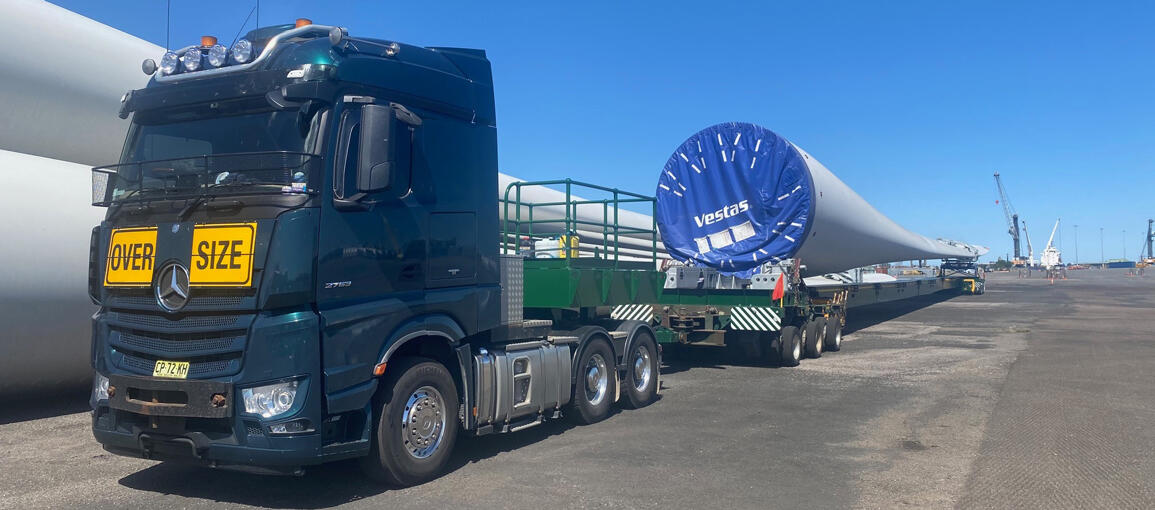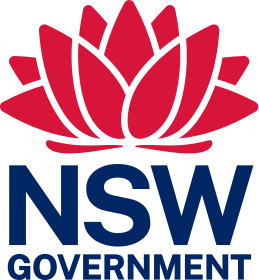Renewables Transportation – Oversize and/or overmass (OSOM) loads
Project overview
Oversize and/or overmass (OSOM) loads are a common sight on NSW roads, but as the name suggests these are not your average heavy vehicles. In general terms, OSOM loads are more than 2.5 metres wide, 19 metres long and 4.6 metres high.

OSOM loads are defined as Class 1 vehicles under the Heavy Vehicle National Law. A vehicle or vehicle combination is considered to be OSOM if it exceeds any general access mass or dimension limits.
Typical examples include:
- Components for renewable energy generation and storage
- Agricultural machines such as harvesters and grain augers
- Vehicle combinations carrying large indivisible items such as mining and construction vehicles, bridge components or building infrastructure
- Special purpose vehicles such as mobile cranes, concrete pump trucks and drilling rigs.
This page has been developed to provide general information about categories of vehicles in NSW, access to the NSW road network and information about OSOM. It also has safety tips for motorists who come across OSOM loads while driving.
More detailed OSOM information for industry operators is available here, including details for declaring an OSOM load, how to seek permission to access the State network with an OSOM load.
Road upgrades to improve OSOM access to network
EnergyCo and Transport for NSW are coordinating the Port to Renewable Energy Zones (P2REZ) road upgrades along the State Road network to help facilitate the development of REZ in NSW. The road improvements are part of the evolution of the NSW road network with Transport responding to these changing needs.
Transport and EnergyCo have identified a number of locations on the State Road network that will be upgraded between Port of Newcastle and Elong Elong and a section of the Castlereagh Highway towards Gulgong.
Information about the project is available here.
Transport will keep the community informed as planning progresses for other road upgrades associated with renewable energy zones.
Port to Renewable Energy Zones (P2REZs)
The Energy Corporation of NSW (EnergyCo) is a statutory authority responsible for leading the delivery of Renewable Energy Zones (REZs) under the NSW Government’s Electricity Infrastructure Roadmap. For more information, visit energyco.nsw.gov.au/port2rez.
Central-West Orana Renewable Energy Zone
The NSW Government is developing Central-West Orana REZ, which is approximately 20,000 square kilometres and centred by Dubbo and Dunedoo. More information is available here.
Managing access to the road network for vehicles of different sizes
Transport’s role is to lead the development of a safe, efficient, integrated transport system. Transport manages State Classified roads across NSW and is responsible for maintenance, major projects and upgrades, heavy vehicle access, special events and incident response to unplanned incidents.
Light vehicles
Transport for NSW is responsible for administering the vehicle standards that apply to all light vehicles.
Light vehicles are defined as:
- motor vehicles with a Gross Vehicle Mass (GVM) of 4.5 tonnes or less
- trailers with an Aggregate Trailer Mass (ATM) of 4.5 tonnes or less.
In general terms, light vehicles can access the entire road network without restrictions, as long as all relevant rules and signage are obeyed.
Heavy vehicles
General access heavy vehicles
A heavy vehicle is a motor vehicle with a GVM exceeding 4.5 tonnes or a trailer with an ATM exceeding 4.5 tonnes.
These heavy vehicles are up to 12.5 metres long for a single vehicle or 19 metres long for a combination, 4.3 metres high and 2.5 wide. Some examples include rigid trucks, rigid truck and trailer, prime movers, semi-trailers and buses. These vehicles also have maximum mass limits (both individual axle and gross mass) that must be complied with. A general access heavy vehicle combination must not exceed 42.5 tonne gross mass. Theses dimensions and mass limits are contained in the Heavy Vehicle (Mass, Dimension & Loading) National Regulation.
In general terms, general access heavy vehicles can access the entire road network without restrictions, as long as all relevant rules and signage are obeyed.
Restricted access vehicle (RAV)
Any single motor vehicle or combination that exceeds the general access dimensions or mass as defined in the Regulation above is considered to be a Restricted Access Vehicle (RAV).
Examples include Performance Based Standards vehicles, B-doubles, road trains, OSOM, mobile cranes, agricultural vehicles and special purpose vehicles.
These vehicles have restricted access to the road network. Restricted access vehicles operate on an approved network under a Notice or with approval via specific permit/s.
More information for freight industry is available here.
How do we assess OSOM vehicles?
Transport assesses OSOM vehicle movements to ensure protection of infrastructure, safety of other road users and minimise impact to network efficiency and projects underway on the route.
A map is available here that shows the approved network for vehicles operation operating under the Multi-State Class 1 Load Carrying Vehicles Mass Exemption Notice and the Multi-State Class 1 Load Carrying Vehicles Dimension Exemption Notice. Vehicles operating under these Notices can be up to:
- Five metres wide
- Five metres high
- 30 metres long
- 115 tonne gross mass
All authorised heavy vehicle road network maps are now published by the National Heavy Vehicle Regulator (NHVR), through the National Network Map.
Driving around OSOM loads
The instance of OSOM loads on our roads is increasing and for the safety of all road users, there are some simple steps you can follow to help keep you safe:
If you see a pilot or escort vehicle, and the OSOM load is approaching you:
- Don’t panic and remain calm
- Reduce your speed
- Move as far to the left as possible and prepare to stop if necessary
- Follow all instructions given by the traffic escort.
If you are approaching an OSOM load, from the rear:
- Slow down and prepare for slow-moving traffic queues
- Be patient. You will be given an opportunity to pass or overtake when it is safe
- Do not risk overtaking an OSOM load without ensuring the road ahead is clear and be prepared for unexpected wind buffeting when overtaking.
Check out these videos from the National Heavy Vehicle Regular (NHVR) about sharing the road with OSOM loads.
Image
Image controls:
Image
Image controls:
Image
Image controls:
The NHVR’s We All Need Space page has more information to help keep you safe around OSOM loads.

